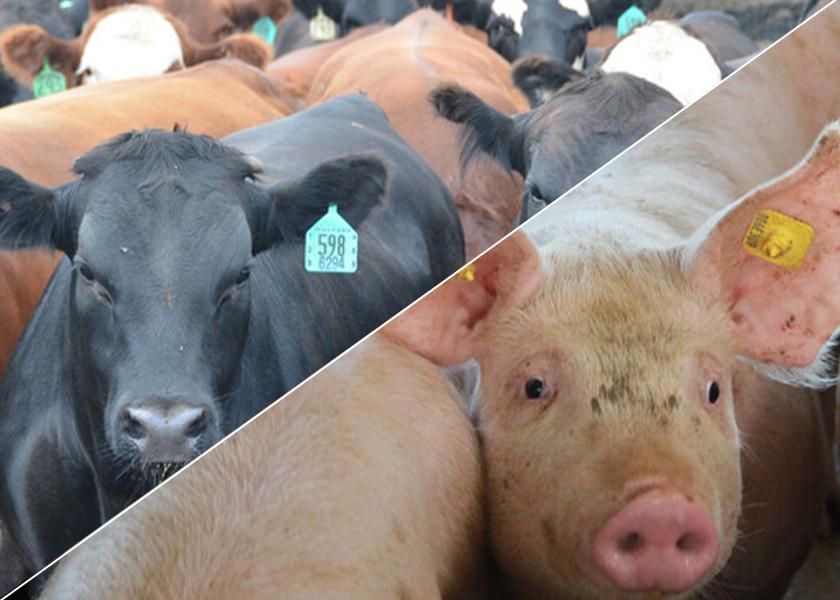Livestock Analysis | January 12, 2022

Price action: February lean hog futures rose $1.00 to $78.85, the contract’s first gain in four sessions.
Fundamental analysis: The hog market’s historical tendency to climb early in the calendar year has strong reasons for existence. Hog slaughter usually slows substantially this time of year from mid-December highs, while the wholesale market often posts gains, with hams sometimes making a strong comeback from December lows as the industry starts building inventories for Easter promotions. Winter weather disruptions may also push prices higher. We see little reason to think that advance won’t prove relatively strong this year, especially with winter hog supplies running about 6.0% under year-ago levels.
These circumstances made the recent three-day breakdown seem overdone, which helps explain the strong rebound today, even as the preliminary quote for the next CME lean hog index fell 7 cents to $75.06. Bearish traders may have been anticipating the fresh bout of wholesale weakness seen yesterday afternoon; that reversed the modest 56-cent gain seen at noon and caused pork cutout to end $4.13 lower at $78.81. Today’s morning rebound to $84.32 probably encouraged bulls as well.
Technical analysis: While today’s rebound partially mitigated the recent breakdown, the mid-range close kept the technical balance favoring bears. Today’s high in February futures at $79.525 established initial resistance at that level, with secondary resistance likely ranging between the contract’s 10-day moving average at $80.52 and its 40-day moving average near $81.08. A push above those levels would have bulls targeting last week’s high at $84.05. Yesterday’s low at $77.55 marks initial support, but a drop below that level would have bears targeting the February contract’s December and October lows at $75.35 and $74.05, respectively.
What to do: Get current with feed advice.
Hedgers: You currently have all risk in the cash market.
Feed needs: You are hand-to-mouth on corn-for-feed and soybean meal needs. Wait on price pullbacks to extend coverage.
Price action: February cattle futures led the market lower, dropping $1.10 to $136.575. March feeder futures tumbled $1.325 to $165.025.
Fundamental analysis: Wholesale beef prices extended a recent rally, with Choice cutout values rising $1.05 early today to $279.27, up over $19.00 from a mid-December low at $260.26. Such strength would appear supportive for cash and futures prices, but it may reflect packing industry slowdowns forced by worker absenteeism due to Omicron infections. That may explain the cash market’s decline over the past month, after live steers reached an average of $140.44 in early December. Significant trading has occurred between $136.00 and $137.00 this week, down $1.00 to $2.00 from last week.
Weaker cash prices and the potential for continued packing plant slowdowns have seemingly caused the late dip below trendline support in place since last fall. We believe such concerns are overdone and are inclined to expect seasonal strength as fed cattle supplies slip to annual lows in February and March. Retailer buying in anticipation of the grilling season is likely to offer late winter-early spring support as well.
Meanwhile, the positive soybean and soymeal response to today’s USDA reports likely pressured feeder futures. Higher expected fuel costs stemming from crude oil’s rally may also have undercut the yearling market, since feedlot operators have to account for those expenses when buying replacement animals.
Technical analysis: Recent weakness has tilted the technical playing field in favor of the bears. The February contract failed at the intersection of its 10- and 20-day moving averages (around $137.90) and could not challenge resistance at its 40-day moving average near $138.28. A close above the latter level would have bulls targeting the late-December high at $141.425. Initial support is marked by Monday’s low at $136.025, with backing from the December low at $135.50. A breakdown below that level would have bears targeting the October 22 low at $133.40, then the October 1 low of $139.825.
What to do: Short-term protective hedges for fed cattle producers may be needed if recent lows are violated.
Hedgers: Carry all risk in the cash market for now.
Feed needs: You are hand-to-mouth on corn-for-feed and soybean meal needs. Wait on price pullbacks to extend coverage.






